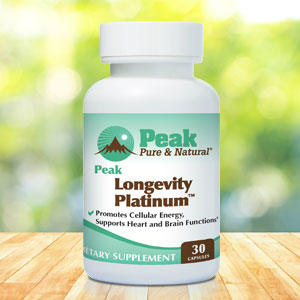Get Easy Health Digest™ in your inbox and don’t miss a thing when you subscribe today. Plus, get the free bonus report, Mother Nature’s Tips, Tricks and Remedies for Cholesterol, Blood Pressure & Blood Sugar as my way of saying welcome to the community!
The fungus that causes Alzheimer’s-like brain changes

There’s a fungus that lives in our bodies called Candida albicans (C. albicans), and is commonly referred to as Candida. This fungus is usually present in small amounts in our gut, skin and mouth.
At this level, candida is harmless. It’s when it starts to grow out of control that it becomes a problem. This happens when the balance of healthy bacteria and yeast is thrown out of whack.
Mild Candida overgrowth is responsible for diseases like thrush, diaper rash and vaginal yeast infections. However, if it really gets out of hand, it can lead to invasive candidiasis, a life-threatening infection that targets your blood, bones, brain and heart.
And that’s not all. Scientists are beginning to discover that even mild Candida overgrowth can affect your health in sneaky ways. Candida has been linked with diarrhea, brain fog, memory loss, constipation, insomnia, joint pain, headaches and more. In fact, mental illnesses like schizophrenia and bipolar disorder have been connected to Candida infection.
It gets worse. Candida overgrowth can actually trigger an infection that mimics a disease dreaded by aging adults…
How Candida sneaks into the brain
Previous research has indicated fungi could be linked to chronic neurodegenerative conditions like Alzheimer’s disease. However, there has been limited understanding of the role they play in the development of these diseases.
A team of researchers worked with animal models to discover how Candida enters the brain and generates amyloid beta (Ab)-like peptides. Ab peptides are toxic protein fragments that are believed to be central to the development of Alzheimer’s.
The researchers also examined how the fungus activates two separate mechanisms in brain cells that promote its clearance.
First, the team found candida produces enzymes called secreted aspartic proteases (Saps) that break down the blood-brain barrier, allowing the fungus to access the brain.
Prior research had shown that a Candida brain infection is fully resolved after 10 days in otherwise healthy mice. In the more recent study, the researchers identified two mechanisms triggered by Candida in brain cells called microglia.
“The same Saps that the fungus uses to break the blood-brain barrier also break down the amyloid precursor protein into AB-like peptides,” says first author Dr. Yifan Wu, postdoctoral scientist in pediatrics at Baylor University. “These peptides activate microglial brain cells via a cell surface receptor called Toll-like receptor 4, which keeps the fungi load low in the brain, but does not clear the infection.”
Candida also makes a protein called candidalysin that binds to microglia via a different receptor. “Candidalysin-mediated activation of microglia is essential for clearance of Candida in the brain,” Wu says. “If we take away this pathway, fungi are no longer effectively cleared in the brain.”
Results of this study represent another crucial piece of information regarding the development of Alzheimer’s.
“The current explanation for this condition is that it is mostly the result of the accumulation of toxic Ab-like peptides in the brain that leads to neurodegeneration,” says corresponding author Dr. David Corry, a professor of pathology and immunology and medicine at Baylor University.
Corry notes that the main line of thinking is these peptides are produced endogenously, meaning our own brain proteases break down the amyloid precursor proteins from which the toxic Ab peptides spring.
However, in the study, the researchers show Ab-like peptides can be made by Candida, which has its own set of proteases for generating them.
Corry says these findings in animal models support further studies to evaluate Candida’s role in Alzheimer’s, which could lead to new therapeutic strategies.
Keeping the fungus under control
Knowing how Candida works in the brain to cause damage definitely gives us more reason to control it. There are a couple of things you can do to keep it from running rampant in your body.
The most important is to not give Candida food to feed on. And the food it loves best is sugar.
The Candida diet suggests not only eliminating most sugars but also improving gut health and restoring the balance of the bacteria and yeast in the body.
Per their site, they suggest non-starchy vegetables, fermented foods like yogurt and sauerkraut, low-sugar fruits like blueberries, proteins like chicken and fish, and pseudo-grains like quinoa — and avoiding pro-inflammatory triggers like gluten and processed foods.
Also be aware that some common medications can upset your body’s pH and make your body ripe for candida to flourish, most notably broad-spectrum antibiotics and oral corticosteroids. Antacids and acid blockers do as well. That’s why it’s important to take probiotics or eat yogurt. Just be careful of the yogurt you choose as most store brands are high in sugar.
Editor’s note: Are you feeling unusually tired? You may think this is normal aging, but the problem could be your master hormone. When it’s not working, your risk of age-related diseases skyrockets. To reset what many call “the trigger for all disease” and live better, longer, click here to discover The Insulin Factor: How to Repair Your Body’s Master Controller and Conquer Chronic Disease!
Sources:
Fungal infection in the brain produces changes like those seen in Alzheimer’s disease — ScienceDaily
Toll-like receptor 4 and CD11b expressed on microglia coordinate eradication of Candida albicans cerebral mycosis — Cell Reports
Candida Albicans — Cleveland Clinic














